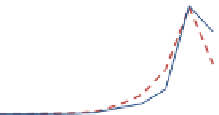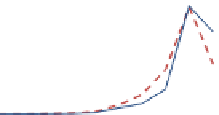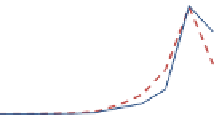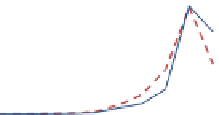Database Reference
In-Depth Information
Fig. 14.4 CDR, SDR, DSR, and RDR as functions of reputation (based on data before 2007).
The
X
-axis shows the reputation bins and the
Y
-axis shows the percentage of users in the bins
correlations are consistent with the general intuitions about Wikipedia that were
used to build the models.
It is important to note that among these parameters DSR is a direct input to
Model 1 and an indirect input to Models 2 and 3. Hence, the positive correlation
between DSR and the user reputation is expected for the three models. For this first
set of graphs shown in Fig.
14.4
, this positive correlation does not give any evidence
about the predictive value of the models, since both user behavior indicators and
user reputation are calculated on the same data.
To show the predictive value of the models, we plot users' behavioral indicators
computed using data up to September 30, 2009, against the reputation values
estimated using data up to January 1, 2007. Figure
14.5
shows the mean of CDR,
SDR, DSR, and RDR, respectively, in each bin associated with each reputation
model, where the users' behavioral indicators are estimated in 2009, while reputa-
tion values used to determine the bins are estimated at the beginning of 2007. The
first observation is that this second set of curves has shapes similar to those in
Fig.
14.4
, indicating that the estimated users' reputations are consistent with their
behaviors - users continue to behave in 2007-2009 as they had behaved before
2007. Furthermore, behavior or reputation is captured in broad strokes, by the
reputation models (Fig.
14.6
).
The values of the behavioral indicators in Fig.
14.5
are slightly different from their
predicted values corresponding to Fig.
14.4
. For example, according to Model 3
applied up to 2007, users with a reputation of 0.1 or below ought to have 69%
reverted data (RDR), whereas in reality during 2007-2009 those users had only 52%
reverted data. Likewise, the same Model 3 predicts that users with a reputation
between 0.8 and 0.9 ought
to be responsible for 37% of the total number







































































































































































































Search WWH ::

Custom Search